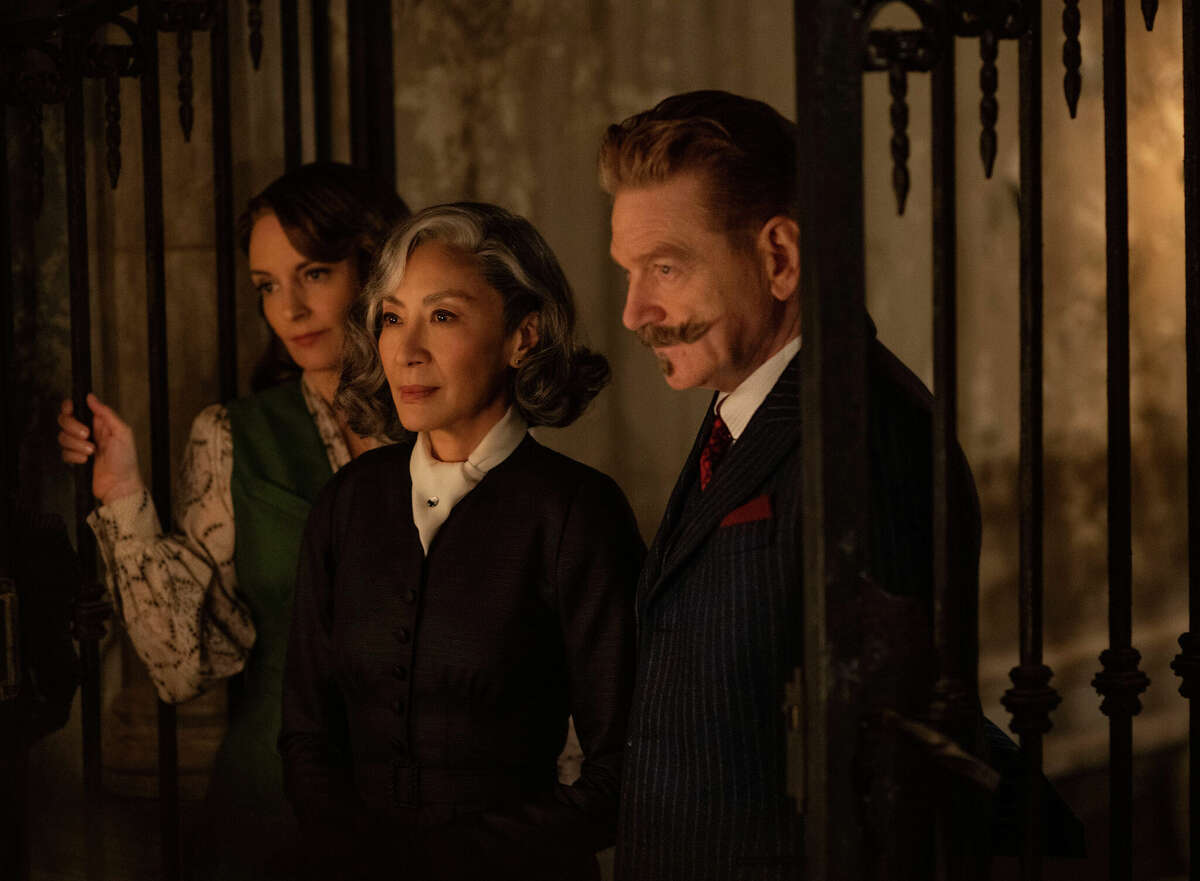
Hercule Poirot and his perfectly waxed mustache are back in A Haunting in Venice. This third entry in actor-director Kenneth Branagh’s revival of Agatha Christie adaptations feels very different from the previous films. Set in a haunted palazzo, it perfectly fits the bill as a spooky mystery – and it takes place on Halloween. Based on Christie’s novel Hallowe’en Party, it’s an adaptation that stands out. Not only because it’s a more unfamiliar story, but because it’s a film that works as a testament to Poirot’s legacy and his struggle to come to terms with the fact that his life has been closely tied to death for so many years. He’s lost all faith, and behind the film’s whodunnit is a journey for him to get it back.
Hercule Poirot (Branagh) is awakened suddenly from a nightmare. The world-renowned detective, whether he likes it or not, is in for another mystery. But having lost faith in God and humanity, he’s no longer the same. Living retirement in post-war Venice, he employs ex-police officer Vitale Portfoglio (Riccardo Scamarcio) to act as his bodyguard, keeping those knocking at his door at bay. However, his mind without a case to solve is like Venice slowly sinking into the sea. This all changes when his crime-novelist friend, Ariadne Oliver (Tina Fey), pays him a visit. She challenges him to an irresistible thrill: attend a seance and help unmask a medium as a fraud.
The home where the seance is to take place is said to be cursed, with those who live under its roof destined to fall to tragedy. Its owner, opera singer Rowena Drake (Kelly Reilly), has hired medium Joyce Reynolds (Michelle Yeoh) to communicate with the tortured spirit of her deceased daughter, Alicia (Rowan Robinson), who is said to have committed suicide. Along with Poirot, Ariadne, and the two aforementioned, others in attendance are Alicia’s ex-fiance, American chef Maxime Gerard (Kyle Allen), Rowena’s housekeeper Olga Seminoff (Camille Cottin), Dr. Leslie Ferrier (Jamie Dornan) and his son Leopold (Jude Hill), and Joyce’s assistants Desdemona and Nicholas Holland (Emma Laird and Ali Khan, respectively). Setting the stage on All Hallow’s Eve means that spirits have come out to play, but Poirot is skeptical of this whole affair. He closely observes the seance, sniffing out any tricks. But when the question is posed of whether Alicia’s death was really suicide, he might be stumped. In a case steeped in the supernatural, events occur that seem unexplainable as the detective desperately searches for rational answers. As screams fill the palazzo throughout the dark, stormy night, Poirot questions if the goings-on are the work of vengeful ghosts or vengeful people.

A Haunting in Venice succeeds at creating the necessary atmosphere of any good ghost story. We are introduced to Venice under a thick mist accompanied by composer Hildur Guðnadóttir’s eerie string orchestra. As cathedral bells toll and the screech of crows echo, death is immediately on the mind. It’s a welcome that’s perfectly foreboding, setting the tone for Poiroit’s darkest case yet. The production design of Rowena’s palazzo also works perfectly to keep the grim tone throughout. Gorgeous art on the walls versus its dimly lit corridors and dreary rooms create a visual contrast of the then versus now; before Alicia’s death and after. It’s cold and doesn’t feel like a home at all; more like a house of sorrows that even the laughter of children on Halloween can’t bring life to. Guðnadóttir’s score also carries with it a spooky feeling that helps keep the audience engaged, almost in a trance, especially during the more tense moments. The film can often be awkward in execution, particularly in its framing of scenes, but never does it not ham up the supernatural elemental of this whodunnit. The killer, too, may appear obvious to many, but even then, Michael Green’s script has enough twists to keep us in doubt.
Murder on the Orient Express is about revenge. Death on the Nile is about greed. A Haunting in Venice is about spirituality. Specifically, if there is life beyond death. At the beginning of the film, Poirot is a man without faith, lost of any belief in spirituality he once had. His life has been a bedfellow with death so many times, and this is a case that deals with death on a whole new level. The meticulous detective finds himself out of his element, jumpy, as he walks into this house that holds the voices of lost souls. You feel as though he’s going mad at the things he’s seeing and hearing that he can’t explain. It’s dizzying as he loses his grip, the camera framed tightly on his face and following him closely in his desperate search for an answer. The answer he’s seeking has nothing to do with the case, however. How does he live with a legacy that is so closely linked to death? He learns that he can’t hide from his ghosts. He must make peace with them and move on, doing what he does best.
The film presents a different Poirot than we’ve encountered, just like the story itself is more unfamiliar than the rest. A Haunting in Venice is an example of the treasure trove of stories that Christie has created that we have yet to explore on film. And, honestly, I’m ready to witness the gears turn in Poirot’s fascinating mind again and again in as many of these as we can get.



